NDVI stands for "Normalized Difference Vegetation Index". NRG stands for "Near-infrared / Red / Green". NDVI and NRG are both ways to visualize the amounts of infrared and other wavelengths of light reflected from vegetation. Because both these methods compare ratios of blue and red light absorbed versus green and IR light reflected, they can be used to evaluate the health of vegetation. It's a snapshot of how much photosynthesis is happening. This is helpful in assessing vegetative health or stress. (Read more here: https://www.agronomy.org/publications/jeq/articles/36/3/832) ## Do-It-Yourself These techniques for vegetation analysis were developed for satellite imagery, but at Public Lab, we've been working a lot on capturing infrared imagery using our DIY [near-infrared camera](/wiki/near-infrared-camera) setup, and combining it with visible bands to produce NDVI images such as the one above. ## What these images mean What exactly are these images we're trying to make? What do they tell us about vegetation, and why? These diagrams should help to understand what it is we're doing and why these are good ways to analyze plant life. ## The NDVI equation [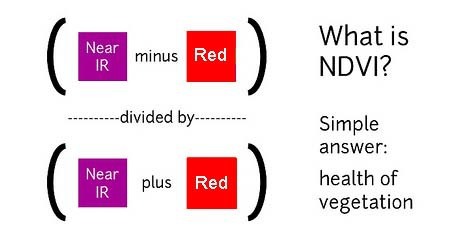](/i/44723) **NDVI = (Near Infrared - Red)/(Near Infrared + Red)** NDVI is a ratio which tries to emphasize photosynthesis while filtering out sun glare. The above equation is run for every pixel, using source data from an infrared photo and a visible light photo, like this pair: [](https://publiclab.org/system/images/photos/000/021/771/original/5390895115_c9d4d38fec_o.jpg) The result can be false-colored to make the high-photosynthesis areas more clear, and used to examine where plants are and how healthy they are. [](https://publiclab.org/system/images/photos/000/021/770/original/PetVISNDVIcomp.png) _Figure above: Normal color photo (right) and normalized difference vegetation index (NDVI) image (left). NDVI image was derived from two color channels in a single photo taken with a camera modified with a special infrared filter. Note that tree trunks, brown grass, and rocks have very low NDVI values because they are not photosynthetic. Healthy plants typically have NDVI values between 0.1 and 0.9. -- @cfastie_ ### Activities Here are a range of activities you can do to produce and interpret your own NDVI imagery, whether downloaded from a satellite imagery provider or [collected yourself using a DIY technique](/wiki/multispectral-imaging) [activities:ndvi] ****   Most DIY converted cameras today (those from Public Lab) use RGN instead of NRG, so the blue channel represents infrared instead of the red channel. That looks like this: [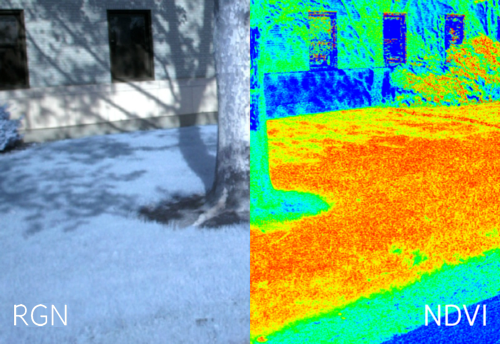](/i/45468?s=o) **** ## NRG imagery Some people are also interested in producing NRG imagery (like the below image), where `Near-Infrared, Red, and Green` are used to compose a picture instead of the usual `Red, Green, and Blue`. [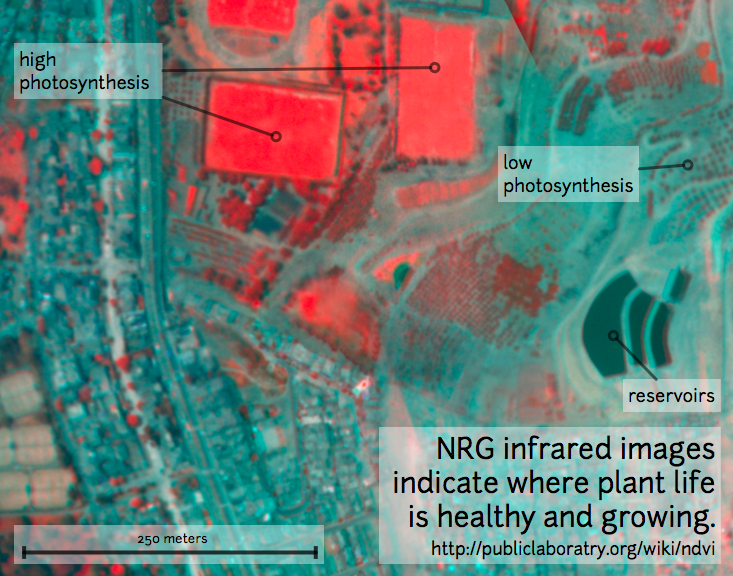](/i/25064) This diagram explains the swapping, which allows us to 'see' infrared as if it were a normal color: [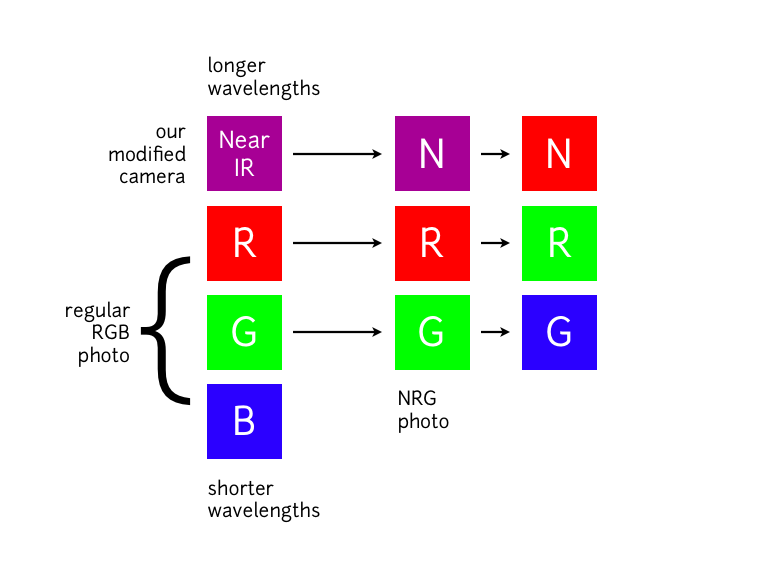](/i/25063) **In NRG images, the deeper and clearer the red color, the denser and healthier the vegetation (more or less).** ### Questions [questions:ndvi] ### Other examples of DIY NDVI imaging From around the internet: Begin watching at 2 minutes to see the resulting imagery: *This topic is part of the [Grassroots Mapping Curriculum](/wiki/mapping-curriculum) series.* **** [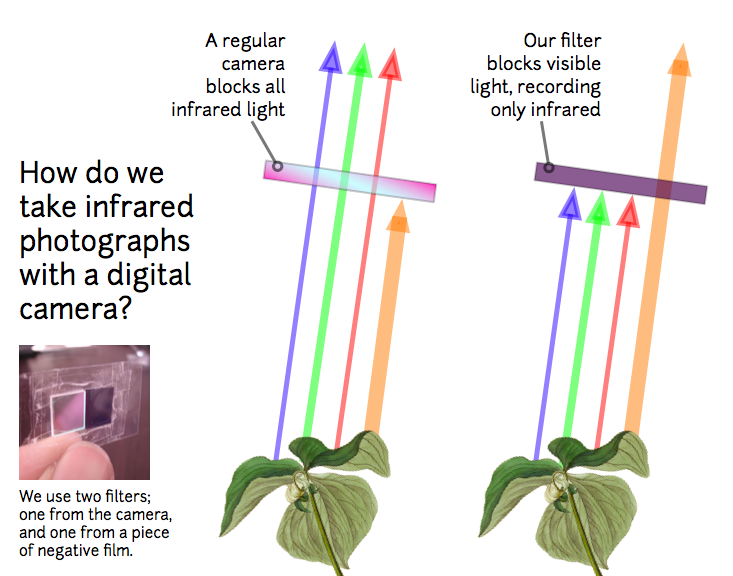](/i/25066) [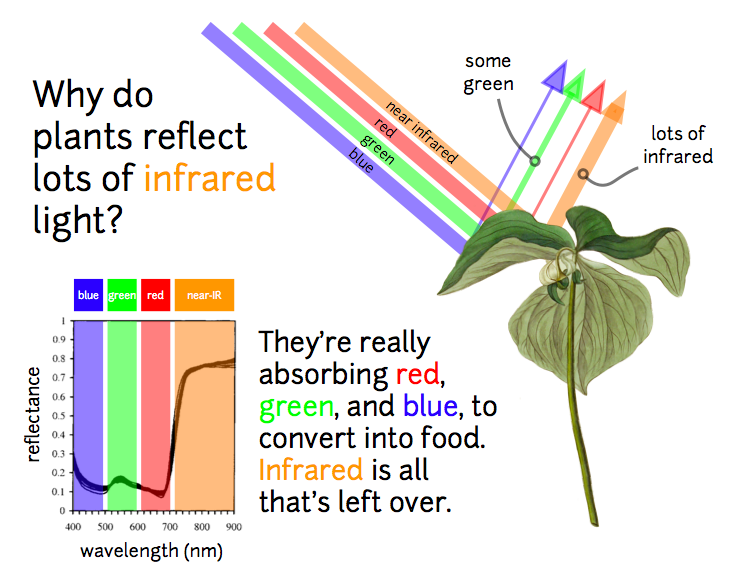](/i/25065) ...
| Author | Comment | Last activity | Moderation | ||
|---|---|---|---|---|---|
| cfastie | "kykytos, you are correct. The equation (NIR-R)/(NIR+R) is the standard one for NDVI. Substituting blue for red as in (NIR-B)/(NIR+B) also works wel..." | Read more » | over 11 years ago | |||
| kykytos | "Hi, I don't understand how can be blue color the Rosco #2007 VS Blue filter when it allows blue light to pass. We see the color of the objects beca..." | Read more » | over 11 years ago | |||
| kykytos | "A pair of doubts: In the equation in the image, it should say (IR-B)/(IR+B) (like in the video) instead of (IR-R)/(IR+R), Shouldn't it? Is the (IR-..." | Read more » | over 11 years ago | |||
| warren | "Haha, lots of fun stuff is possible. Try JavaScript math functions: R:Math.pow(R,2) G:Math.pow(G,2) B:Math.pow(B,2) I'm making a docs page here: h..." | Read more » | over 11 years ago | |||
| cfastie | "Huge Breakthrough! We love sliders! Here is NBG of an astroturf putting green (R*S, B*1.3, G*0.1, WHEN S=100): And here is ENDVI = ((R+G)-..." | Read more » | over 11 years ago | |||
| donblair | "(... and in case the resultant HTML is at all useful, it's here: https://github.com/Pioneer-Valley-Open-Science/infragram-js ) " | Read more » | over 11 years ago | |||
| donblair | "I've got your code working locally, and it's gorgeous. Just to play around, I tried adding in some of your video instructions as explanation on th..." | Read more » | over 11 years ago | |||
| donblair | "HOLY COW. " | Read more » | over 11 years ago | |||
| jyalarid | "Hi, So with this setup I do not need two cameras?... I just finished making this tonight and I am hoping to snap some pictures tomorrow " | Read more » | over 11 years ago | |||
| warren | "Wow, fantastic. I also think that the new interface quickly exposes that my guess that this camera was producing some photosynthetically-based diff..." | Read more » | over 11 years ago | |||
| cfastie | "That's really good. I think people will appreciate the explanations. Nice clone of the color table. Maybe if it goes from yellow to magenta instead..." | Read more » | over 11 years ago | |||
| donblair | "Hi Chris -- great stuff! Changed the color bar in an attempt to match yours (haven't yet implemented the max / min values, yet), and added some ex..." | Read more » | over 11 years ago | |||
| cfastie | "The blue channel display is a good addition. It is not only a good diagnostic, but it helps everybody understand how the whole infrablue thing work..." | Read more » | over 11 years ago | |||
| donblair | "Chris -- I'm looking into generating the color table you're using -- it does indeed nicely distinguish above- and below-zero NDVI values -- and I'l..." | Read more » | over 11 years ago | |||
| cfastie | "Another good diagnostic tool for the Infrapix app could be display of a grayscale image of the blue channel of the infrablue photo. For example, th..." | Read more » | over 11 years ago | |||
| cfastie | "I think the new consistent relationship between NDVI values and color is good. If this causes some infrablue photos to produce boring (all the same..." | Read more » | over 11 years ago | |||
| donblair | "Follow-up -- the downside with having a set colortable for NDVI, from -1 to 1, is that a lot of the images are going to look pretty boring. One id..." | Read more » | over 11 years ago | |||
| donblair | "Update -- I've changed the infrapix code so that it always displays a color table that spans the full range of possible NDVI values (-1 to 1). Not..." | Read more » | over 11 years ago | |||
| donblair | "Jeff -- great, promising set of experiments here! Re: the color settings on the Infrapix app -- sorry, now I see (from your note, and in conversat..." | Read more » | over 11 years ago | |||
| warren | "BTW, this post is now the 7th most popular research note (by view count) on the site! " | Read more » | over 11 years ago | |||
| warren | "Another way to approach this is to standardize everything as much as possible, so it follows a well-described, simple, standard process, which we c..." | Read more » | over 11 years ago | |||
| pablo | "Great Jeff, I had missed this post. Any conclussions to extract from the photos about the landfill? Besides, wrong first link! " | Read more » | over 11 years ago | |||
| cfastie | "Liz, The complete process is probably not described anywhere. Okay, now it kind of is: http://publiclab.org/wiki/infrablue-white-balance This will..." | Read more » | over 11 years ago | |||
| cfastie | "Bilco1, Let us know what is not working. There are several people who have the process figured out and I'm sure we can get it working for you. The ..." | Read more » | over 11 years ago |